Asus PC-DL Deluxe: 875 with Dual Xeons
by Wesley Fink on September 6, 2003 12:06 AM EST- Posted in
- Motherboards
Asus PC-DL: Board Layout
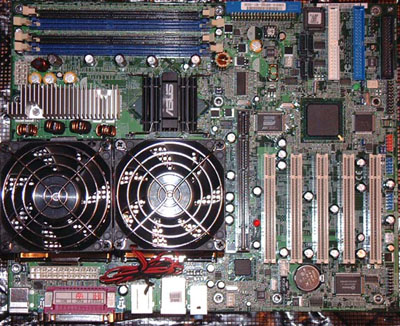
The PC-DL is a full-size ATX board, which will fit in a standard ATX case. Many multiple CPU designs require expensive specialized cases, but the Asus will fit any standard ATX case. As we have already discussed, you will need an ATX size Xeon Power Supply with 24-pin and 8-pin connectors form Vantec, Antec, Enermax and others.
It is more than a little unfair to discuss layout concerns about a Dual-Processor board as if it is a standard ATX board. Usually this type of board is purchased and a case is chosen to meet the board needs. With that in mind, board layout matters more in telling you what you need in a case.
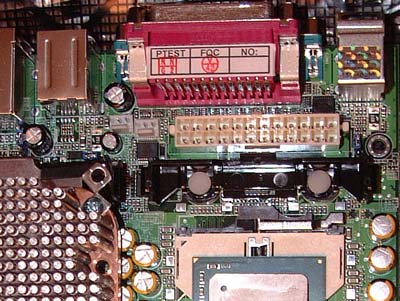
The 24-pin power connector is in a very tight location, squeezed between the Dual Xeon sockets and the back IO connectors. There is so little clearance that you actually have to use a screwdriver to release the catch for the connector when it is removed. Fortunately, it is located near the top of the board, so it is easy to clear the CPU sockets with this cable. However, make sure your case and power supply will allow you to snake the bulky 24-pin between the CPU’s and back IO without obstructing air flow to the power supply. This is much easier in some case designs than others.

The 8-pin 12V connector is located at the top edge of the motherboard between the memory slots and the CPUs. It’s about as ideal a location as you will find, and should be easy for almost any case design.
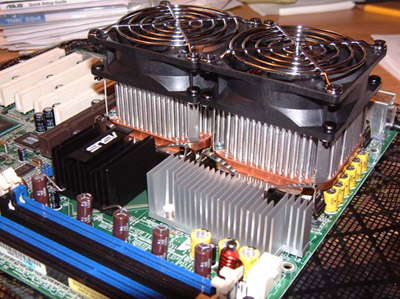
When you first look at the dual CPU-area it appears cramped, but it really isn’t. A lot of thought went into this area, as you can see by our ability to mount Dual Swiftech MCX603 heatsink with Panaflo 80mm fans for cooling. You should be able to mount just about any Xeon cooling solution available on the PC-DL.
There are a huge number of capacitors around both Xeon sockets, but Asus was very careful to control height of the capacitors so heatsinks could overhang the capacitors without interfering with their operation.

Since many (who will consider this board) are not really familiar with Xeons, you should be aware that standard P4 heatsinks and fans do not work on a Xeon. The mounting clips themselves are different. We learned the hard way that Xeon mounting brackets, clips, and heatsinks are very difficult to find in the open market. We received the Asus PC-DL and 2 bare Xeon 3.06 processors. After a lot of searching for Xeon heatsinks with no luck at all, we were finally able to locate them at Frozen CPU, a national cooling and case modding web specialty store. Our sincere thanks go out to Mark Friga and his crew for getting us set-up with Swiftech Xeon heatsinks and Panaflo fans so we could complete our review.

Most of you will buy Retail Xeons, which include the fan and necessary hardware, but with boards like Asus PC-DL coming to the market, targeting the gaming and PC Enthusiast market, you will likely see a growing aftermarket for Xeon cooling solutions like the Swiftechs we found at Frozen CPU. Overclocking Xeons was not something an IT professional using a Xeon would even think about, but gamers and computer enthusiasts will take a different approach to what to do with their Dual-Xeon 875 boards.
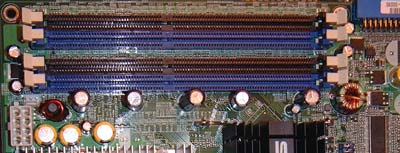
Like the P4 Canterwood boards, the PC-DL supports up to 4GB of Dual-Channel Unbuffered or ECC memory. The board does not support registered ECC memory. This would be a very large limitation for a board aimed at the server market, and is another indication that the PC-DL is geared toward the workstation and Enthusiast markets.

The 875p North Bridge is cooled by the same massive heatsink used on the P4C800-E, which we recently reviewed. Asus also turns the heatsink 90 degrees on the PC-DL. The heatsink remained very cool during operation of the PC-DL.

With all of the space required for dual processors and the more robust power connectors required for their operation, there are compromises that must be made, particularly on an ATX-size board. Since a full-tower case will very likely be used with a Dual-Xeon board, the location of the IDE and floppy connectors is extremely poor. All of the connectors are located at the very bottom right of the board, which means you will need some very long cables to reach your upper-bay Optical drives. You will need to pay careful attention to case design and cables to make sure everything will work properly with this layout.
The location of the floppy connection at the very bottom right of the PC-DL is particularly bad. Boards with RAID capabilities like the PC-DL require a floppy for drivers during the Operating System install. If your tower case has the floppy at the top, you will need an extra-long specialty floppy cable to reach. With a floppy location at the bottom of the “external” stack, you will have no problem with this location.
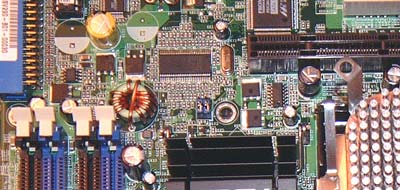
With all that is crammed onto this standard ATX board, we were pleased to find the location of the AGP slot (in relation to the Dimm slots) still allows easy removal and replacement of memory modules. The video cards that would likely be used on the PC-DL would be top-line with additional power needed, or double-slot workstation graphic cards. This would make removing the video card to switch or upgrade memory a terrible nuisance. Fortunately, you won’t have that problem with the PC-DL.

The PC-DL is a 4-phase power design, and Asus also added a massive heatsink to cool the power transistors that deliver power to the board. These are both welcome precautions to ensure accurate and reliable power regulation on the PC-DL.










29 Comments
View All Comments
Anonymous User - Monday, September 8, 2003 - link
Xeon DPs are still at the 533 right now. Xeon MPs are worse off at just 400. Faster Xeons are just around the corner though.sprockkets - Monday, September 8, 2003 - link
Aren't the Xenons at 667FSB? But as usual, they share the bandwidth, which is really bad since they crave bandwidth, but good for memory access. But clearly the HT idea is faster.Running though at 800 maybe really too hard to do, or not ?
Anonymous User - Monday, September 8, 2003 - link
Remember Xeons were built for the server market where stability is king. Intel knew this and this is why the 533MHz FSB has stuck around so long. As Intel rolls out more 800Mhz FSB chipsets and P4 chips the 800Mhz FSB Xeon should follow several months later. The same process could be seen back when the 400Mhz FSB Xeons were around.Anonymous User - Monday, September 8, 2003 - link
Well don't take my word for it, wait for the results yourself and then you can admit you are a fool! Clueless kids looking to argue... What a waste of time.Anonymous User - Sunday, September 7, 2003 - link
Is HyperThreading enabled for those Dual Xeons?Anonymous User - Sunday, September 7, 2003 - link
@13 "it would not improve performance enough to even be competitive"lol... what reviews have you been reading? the extra fsb makes a huge difference! THG overclocked the Xeons by 7 mhz and averaged somewhere around 4-4.5% performance increase! That's pretty damn significant. Even bringing the Xeons up to 667 FSB would make it a very good performer!
Anonymous User - Saturday, September 6, 2003 - link
Don't believe everything you read... ESPECIALLY from Intel. Go read THG's review and *maybe* you'll have a better appreciation for why Intel ain't likely to release a 800 MHS FSB Xeon any time soon and it would not improve performance enough to even be competitive when a 2.0 Gig. Opteron/A64 blows the doors off a dual 3.06 Gig. Xeon. If you wanna feel bad... look at how the dual Opteron beats up on a dual Xeon.Anonymous User - Saturday, September 6, 2003 - link
Read the news -- Intel has said it WILL produce 800Mhz FSB Xeons (when is a bit of a question: the last report I read over a month ago said Q1 '04 but they may have moved it up -- that's what this article seems to imply).Anonymous User - Saturday, September 6, 2003 - link
There are technical reasons why the Xeon can't do 800 MHz FSB. Tom's Hardware went into some of the reasons in their dual Xeon test where Opteron also smoked the Xeon even with the new L3 cache. The reality is that Intels current processors have just become obsolete with Opteron and A64. The benches for A64 will show equal or better performance for a single CPU than Opteron. For multi-processor systems above (4) CPUs the Opteron has an advantage over the A64. As the benches show Intel simply has nothing to compete in either the desktop or server segments and soon the A64 will be available in laptop to so Intel needs to get it in gear. Needless to say all Opteron/A64 CPUs will run both 32-bit and 64-bit O/S's. Linux has been available and Windoze will be available soon. AMD has definitety made a qunatum performance leap over Intel this time, no doubt.Anonymous User - Saturday, September 6, 2003 - link
Remember that server boards have to go through more stringent evaluation then desktop boards. I don't think Intel even considers 800Mhz FSB stable enough for their Xeons yet, and it's a shame. There is only so much increasing your L2 cache size can do for you. I don't think you can use 2.4Cs on this board even if you could find a socket adapter -- remember the 'overclocking settings' were limited to 133->165 (that's almost the 667Mhz FSB that Intel might move the Xeon to soon). So you'd be underclocking it by at least 17%, and at that point why bother? That's if you can find some video card that will take a 79Mhz AGP speed -- good luck with that.